Main Page
Spectrograph / Spectroheliograph / Spectroscope
Projects
Updated 4/6/19
 NEW: 3D printed spectrograph for comets here!
Gigantic solar spectrum with 1200 grating just completed!
NEW: 3D printed spectrograph for comets here!
Gigantic solar spectrum with 1200 grating just completed!
 More Winter specta and carbon stars! 3/3/18
Winter Spectra of bright and interesting stars with the 10 inch, 2/25/18
Uploaded 10/13/16:
More scans of UV lamps including new Adafruit UV Leds
Uploaded 10/3/16:
300 lpmm scans of UV light sources
Uploaded 3/30/14
More filter and plant scans can be found here!
More Winter specta and carbon stars! 3/3/18
Winter Spectra of bright and interesting stars with the 10 inch, 2/25/18
Uploaded 10/13/16:
More scans of UV lamps including new Adafruit UV Leds
Uploaded 10/3/16:
300 lpmm scans of UV light sources
Uploaded 3/30/14
More filter and plant scans can be found here!
 Uploaded 3/23/14
Uploaded 3/23/14
|
Lets start with
a brief overview of the instrument I am currently building and
optimising. It is about 18 inches long, and seen here with the
covers removed just before I painted the inside black, which
would have made such an image hard to see at best. Key features
include the "Flip Mirror" and "Flip Slit"
which allows unusual versitality and ease of use. Three different
gratings can be inserted on the shaft of the electronic shaft
encoder. This set includes the 300, 600, and 1200 lpmm reflection
gratings. A unique feature is the imaging lens is zoomable from
12 to 70mm allowing an optimal field for each grating to be realized.
I can JUST get the entire visual spectrum with the 300 grating
and zoom set for 30mm.
The entire unit
is constructed from 1/4 inch Popular hard wood and is quite light
for its size. Currently I am using Imaging Source cameras for
the CCD detector, seen here is a DMK31.
|
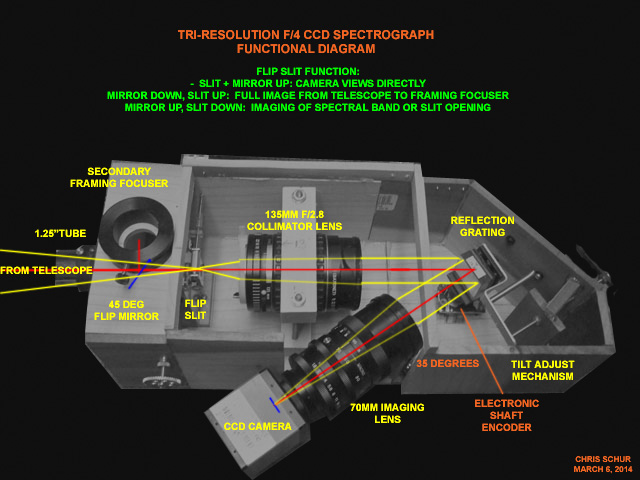 And the final appearance after painting and labeling:
And the final appearance after painting and labeling:
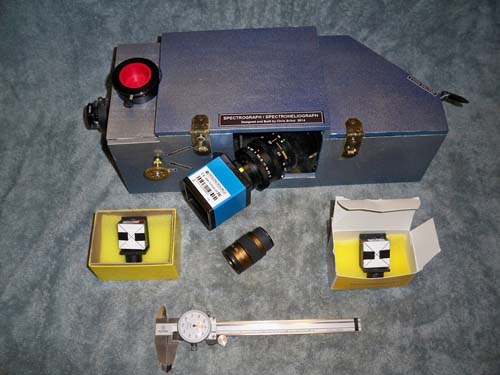 Latest Results:
Latest Results:
 March 23, 2014
Final Results with the 600lpmm grating on the Sun - Write up HERE
March 23, 2014
Final Results with the 600lpmm grating on the Sun - Write up HERE
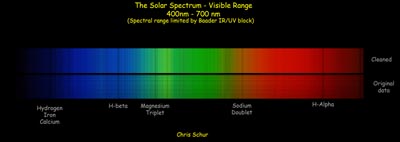 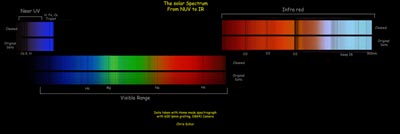
 March 16, 2014
March 16, 2014
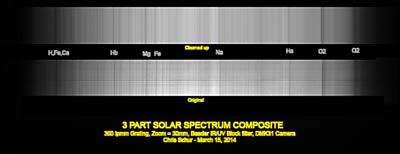 Solar Spectrum - Visible Range 400 - 700nm
with 300 lpmm Grating
Solar Spectrum - Visible Range 400 - 700nm
with 300 lpmm Grating
|
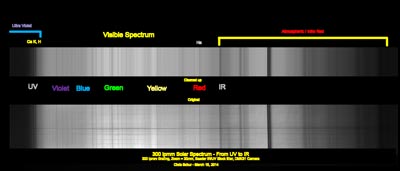 Solar Spectrum - Full Range 350 - 800nm
with 300 lpmm Grating
Solar Spectrum - Full Range 350 - 800nm
with 300 lpmm Grating
|
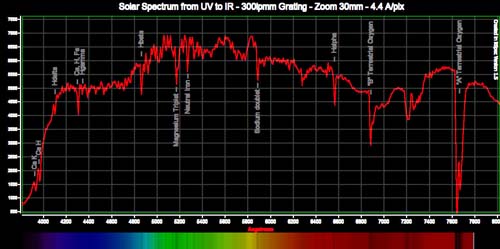 Click to Enlarge
Click to Enlarge
| Left:
Produced in RSpec, this analysis of the full range solar spectrum
is annotated with the prominent features and a synthetic color
spectrum at the bottom. |
|
Some Filter scans.
To produce these
visible band spectral scans of various interference filters,
a Quartz Halogen light source was used as a source for the tests.
The spectrums were imaged as .avi files and the filter raw response
was divided by the lamp spectrum for an absolute response, with
accurate transmission percentages on the left side.
|
Click all images for a full size view!
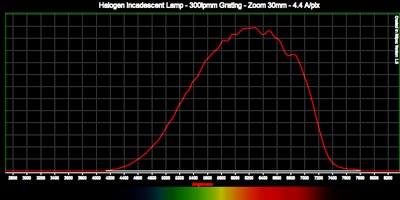 Halogen Light Source full range from
UV to IR
Halogen Light Source full range from
UV to IR
|
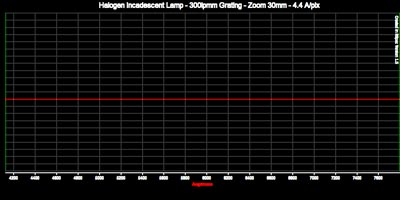 Dividing the Halogen raw image by itself yeilds
a flat line - this is the source for the filters
The line is at 1.00 = 100% transmission
Dividing the Halogen raw image by itself yeilds
a flat line - this is the source for the filters
The line is at 1.00 = 100% transmission
|
 Calibration source is a neon lamp. The resolution of
the system can be evaluated (15A FWHM)
Prominent spectral lines indicated and at the bottom a
synthetic spectrum that matched the visual view.
Calibration source is a neon lamp. The resolution of
the system can be evaluated (15A FWHM)
Prominent spectral lines indicated and at the bottom a
synthetic spectrum that matched the visual view.
|
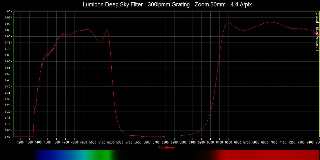 Lumicon Deep Sky Filter
Lumicon Deep Sky Filter
|
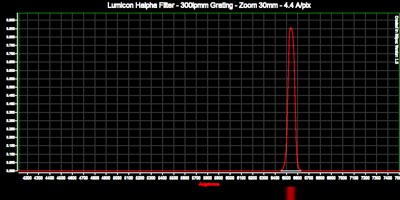 Astrodon 6nm Hydrogen Alpha Filter
Astrodon 6nm Hydrogen Alpha Filter
|
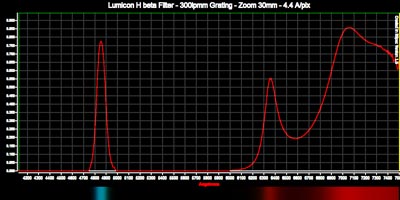 Lumicon H Beta filter
Lumicon H Beta filter
|
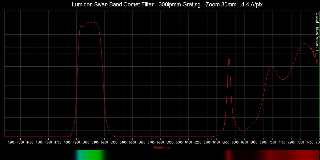 Lumicon Swan Band Comet Filter
(yes it looks like an UHC, but it is different)
Lumicon Swan Band Comet Filter
(yes it looks like an UHC, but it is different)
|
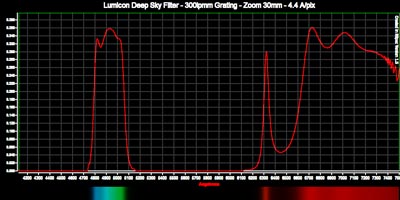 Lumicon UHC filter
Lumicon UHC filter
|
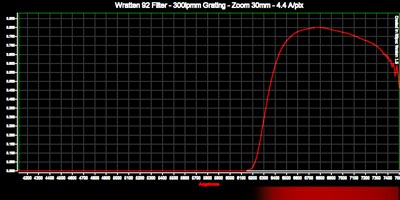 Wratten 92 Deep Red gel filter
Wratten 92 Deep Red gel filter
| |
Previous Latest Uploads:
1. Basic spectrograph layout during construction with lots of photos
2. Some preliminary solar spectral close ups with the 1200 lpmm grating 3/1/14
 Spectrographic Projects with the Star Analyzer Interfocal Grating and Prisms
Spectrographic Projects with the Star Analyzer Interfocal Grating and Prisms
Comet Austin
 May 6, 1990,
Objective Prism Spectra
400mm f/6.3, 15mins on
Ektar 1000, Payson
May 6, 1990,
Objective Prism Spectra
400mm f/6.3, 15mins on
Ektar 1000, Payson
| Here
in this image for example is Comet Austin with a flat wedge shaped
prism mounted in front of a 400mm lens. You can see that the
spectrum has multiple images of the comets coma in it which for
the most part represent ionised molecules such as CN and Swan
bands present. This comet was quite active and photographed with
a very green coma. Comets with plenty of dust tend to mute the
gasses spectrum and are primarily that of reflected sun light.
This appears as a bland spectrum with dark lines instead of bright
ones. You will also notice that the red part of the spectrum
is rather shortened, but the blue is drawn out. This is the non
linearity that prisms posess because they work by the principle
of refraction, and blue wavelengths are refracted more than red.
(Think rainbow). | 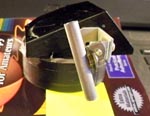 | Left:
A shot of the 15 degree surplus prism I use when shooting comets
in this manner. You can see Ive mounted it on a coffee can jar
lid which fits over the lens snugly, and Ive painted it black.
Also a small sighting tube is mounted on the top to aim the prism
at the comets. It is adjusted to compensate for the angle of
the prism. |
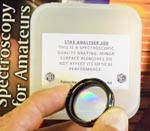 | Another
method for obtaining spectra of celestial objects is with transmission
gratings. These are a resin film mounted on glass or on a plastic
sheet with grooves ruled into thier surfaces to disperse the
light. Those rainbow reflectors you see on products or credit
cards are an example of this, as are the rainbow pattern you
get with the reflections off of a CD or DVD disk. I use a professional
grade blazed grating in an 1.25" filter ring called the
"Star Analyzer" by Patton Hawksley, Inc. For cometary
spectra, a focal length is chosen such that the image is small
and point like. For example, a tiny 12th magnitude average comet
is small enough to allow direct imaging through the SA unit and
obtain a resonably clear spectrum. |
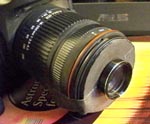 | Here we have mounted the
grating on the front of the camera lens, which when zoomed to
200mm allows a large full spectrum to be imaged. This is useful
for small point like celestial objects that are not too large
to blur the spectra out into a mush. This is suitable for small
objects like stars fields and small but bright comets. The next
panel shows an image taken with this setup on the stars of the
belt of Orion: |
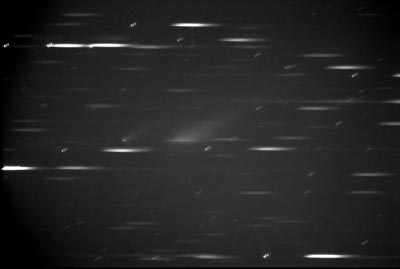 | Here
is an example of this in effect. A very faint comet ISON when
it was dim and small in the 12.5" scope made a suitable
target for the transmission grating. In this image at the left,
you can see both the standard sharp stars image, and to thier
right side is the drawn out short spectrum. ISON is to the left
of center, and you can see its tiny nucleus and short tail. To
its right is its spectrum which can be analyzed with appropriate
software for signatures of molecules. |
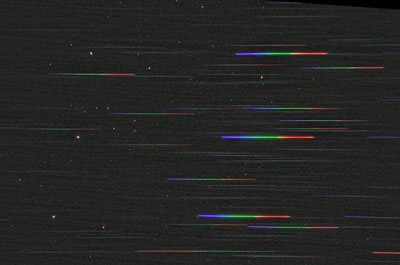 | Click
on this thumbnail for a whole page of some wide field spectroscopic
survey images with the above setup! Each star is a point source
and will be visible dimly on the left side, while the spectra
of each star is a colored streak to its right. This grating is
100 lines per millimeter ruled, such low dispersion is great
for dim objects as it does not spread the light out too much
and make it hard to see. |
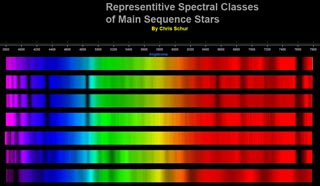 Low Resolution Spectroscopic
Series - OBAFGKM
Low Resolution Spectroscopic
Series - OBAFGKM
|
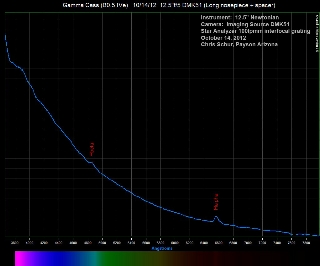 Be Stars
(B stars with emission lines)
B0 - B9
Be Stars
(B stars with emission lines)
B0 - B9
|
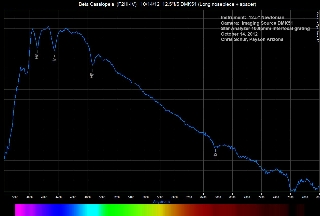 Additional
Main Sequence Normal
Dwarfs to Super Giants
OBAFGKM
Additional
Main Sequence Normal
Dwarfs to Super Giants
OBAFGKM
|
Planets and Moons
-- Europa vs Io
|
 HOME GALAXIES EMISSION NEBS REFLECTION NEBS COMETS
GLOBULARS OPEN CLUST PLANETARIES LINKS
HOME GALAXIES EMISSION NEBS REFLECTION NEBS COMETS
GLOBULARS OPEN CLUST PLANETARIES LINKS
|
 And the final appearance after painting and labeling:
And the final appearance after painting and labeling:
 Latest Results:
Latest Results:


 And the final appearance after painting and labeling:
And the final appearance after painting and labeling:
 Latest Results:
Latest Results:

